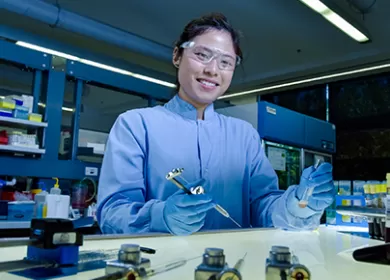Don’t have an account?
Select the donation type you’d like to make
How mechanical engineers see red blood cells
There’s a lot to learn by looking through the eyes of a mechanical engineer.
During its 120-day lifetime, a red blood cell completes around 170,000 circuits of your body. That’s about 500 km. In each circuit, the red blood cell needs to squeeze through tiny capillaries to deliver oxygen to the surrounding tissues. It’s a remarkable feat, and one that becomes more difficult for older blood cells, especially those that have been stored outside the body before a transfusion.
“Red blood cells become less flexible as they age. They also change from their flattened disc shape to a spherical shape which doesn’t function as efficiently. When we store blood for transfusion, these changes happen more quickly than they do in the body. Understanding what triggers the changes may help us find ways to make stored blood last longer,” explains Professor Robert Flower.
These changes suggest that something has changed in the network of molecules that supports the cell. Structural supports and changes in flexibility are areas that engineers understand really well, so to understand the changes in flexibility of red blood cells, researchers at Lifeblood formed an unlikely alliance with mechanical engineers at Queensland University of Technology.
The researchers have used computer modelling methods to develop a mathematical model of red blood cells. The computer model describes the shape and physical behaviour of red blood cells using the concept of a network of springs and anchors inside a flexible casing, which represents the membrane that surrounds the red blood cell. The model can then be used to predict real world outcomes that may be difficult to test otherwise. For example, it shows us how red blood cells could flex and squeeze through a narrow capillary. In future, it may help us find storage solutions that will keep blood cells fresh for longer after donation.
Prof Flower and his team are working with Prof YuanTong Gu and colleagues from the School of Chemistry, Physics and Mechanical Engineering at Queensland University of Technology on the project, which was funded by a grant of $350,000 from the Australian Research Council. Researchers have compared theoretical predictions from the computer model, with sensitive real world measurements of the red cell membrane.


